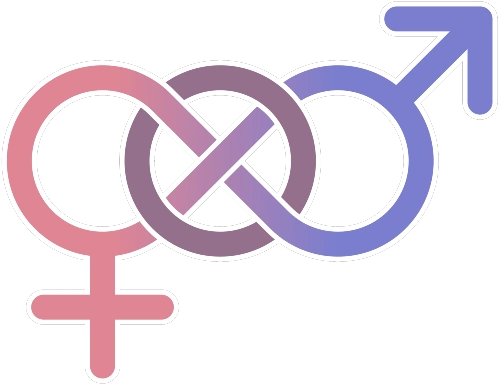Pansexuality,[1] often shortened to Pan, is sexual attraction, romantic love (also referred to as Panromantic), or emotional attraction toward people of either sex or any gender identity.[2][3] Pansexual people may refer to themselves as gender-blind, asserting that gender and sex are insignificant or irrelevant in determining whether they will be sexually attracted to others. [4][5]
Some Pansexuals will ignore gender and will prefer to see the personality of their sexual/romantic/emotional interest instead, but an overall shared trait is that every pansexual is attracted to all genders.
The Flag
The pansexual flag is made up of three colors, pink, yellow, and blue in order. The pink and blue represent females and males (respectively), and the yellow represents everything in between or outside the gender binary. There has been some discourse on the flag, with the flag appearing to originally belong to the Kingdom of Cochin, but nothing is for sure. The discourse had lead to a redesign of the flag by some users on Twitter.
History
The term was first coined in 1917 by Sigmund Freud. His definition denoted the idea "that the sex instinct plays the primary part in all human activity, mental and physical.”
It was later used again in 1959 as a symptom of pseudo-neurotic schizophrenia.
Contrary to popular belief, its origins weren't a transphobic LiveJournal entry. It first picked up traction as a sexuality in the 70s, where in 1972, it was described as "not limited in sexual choice, and in 1981, described by Rita Mae Brown on her experience as not caring "If I fall in love with a black or a white or a man or a woman or an old or young person. I just care that they have a good heart."
It was picked up by the BDSM kink community in the 1980s to include genderfluid people, and was used most in the 90s adopted to include transsexuals.
Distinctions Between Other Labels
Pansexuality is often compared to other labels on the Multisexual Spectrum, most notably Bisexual and Omnisexual.
With Bisexuality, many will say that they are the same and that the pansexual label is "unnecessary". However, the differences are still there. For example, Bisexual is the attraction to two or more genders and is moreso a fluid and broad identity; attraction between two and all genders is possible, with or without preference. With Pansexuality, the attraction is more specific; a pansexual is attracted to everyone, regardless of gender.
With Omnisexuality, both share very similar meanings. Both mean attraction to all genders, but where the difference comes in is that Omnisexuals often have a preference to gender, whereas Pansexuals do not.
All of these labels, including Polysexual and Abrosexual, are on the Multisexual Spectrum.
Days of Recognition
The following days of the year officially recognize Pansexual and Panromantic folks.
May 24th: Pansexual and Panromantic Awareness Day. An annual day to promote visibility and celebrate Pansexual and Panromantic folks.
December 8th: Pansexual Pride Day. An annual day to celebrate and promote Pansexual and Panromantic pride.
December 6th - December 12th: Pansexual Week. A week to celebrate Pansexuals and Panromantics.
References
- ↑ The American Heritage Dictionary of the English Language – Fourth Edition. Retrieved February 9, 2007, from Dictionary.com website
- ↑ Mental health issues in lesbian, gay, bisexual, and transgender communities American Psychiatric Pub
- ↑ Sex and Society Marshall Cavendish
- ↑ Diamond, L., & Butterworth, M. (2008). Questioning gender and sexual identity: Dynamic links over time. Sex Roles. Published online March 29, 2008.
- ↑ The Oxford Dictionary of English defines pansexuality as, "not limited or inhibited in sexual choice with regard to gender or activity". definition of pansexual from Oxford Dictionaries Online. Oxforddictionaries.com. Retrieved on 2012-06-20.
